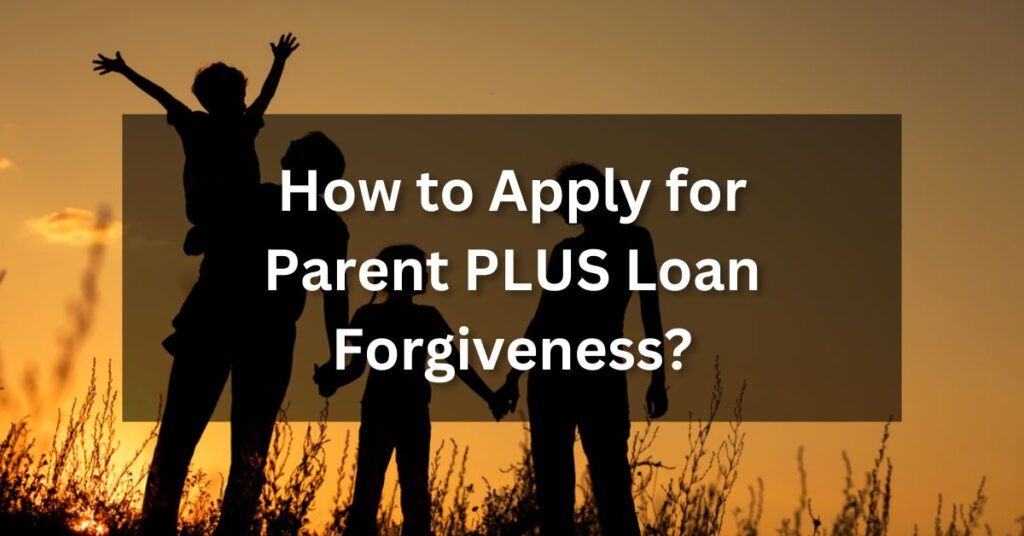Parent PLUS Loan Forgiveness is a valuable resource for parents looking to assist their children in paying for college. These loans offer flexible repayment options and can cover the full cost of attendance, minus any other financial aid received.

However, Parent PLUS Loans do not qualify for many traditional federal student loan forgiveness programs. Despite this limitation, there are still options available for parents seeking relief from their Parent PLUS Loan debt.
Should I Apply for Parent PLUS Loan Forgiveness?
It can be frustratingly complex to navigate forgiveness programs, especially for Parent PLUS Loans. Despite meeting all requirements and making the required payments, many borrowers are denied forgiveness for reasons they didn’t anticipate.
Programs like Public Service Loan Forgiveness and Income-Driven Repayment, while promising, have not been consistently successful. This unpredictability has left many borrowers disappointed after years of waiting for forgiveness.
In reality, loan forgiveness is like a gamble. While some may succeed, many are left dissatisfied. It might be more rewarding to pay off your student loans quicker and according to your own plan.
How to Apply for Parent PLUS Loan Forgiveness?

Applying for Parent PLUS Forgiveness involves several steps. Here’s a general guide to help you through the process:
- Check Eligibility: Ensure that you meet all the requirements for Parent PLUS Loan Forgiveness. This includes making 120 qualifying payments while working full-time for a qualifying employer.
- Gather Documents: Collect all necessary documents, including your loan information, payment records, and employment certification forms.
- Submit Employment Certification Form: Fill out the Employment Certification Form annually or whenever you change jobs to track your qualifying payments.
- Make Qualifying Payments: Ensure you’re on a qualifying repayment plan and make 120 qualifying payments. Only payments made after October 1, 2007, while employed full-time by a qualifying employer, count towards the 120 payments.
- Submit Forgiveness Application: After making 120 qualifying payments, submit the Loan Forgiveness Application for Parent PLUS Loans to apply for forgiveness.
- Wait for Decision: Your application will be reviewed, and you will be notified of the decision. If approved, the remaining balance on your Parent PLUS Loan will be forgiven.
- Consider Tax Implications: Any forgiven amount may be considered taxable income, so it’s important to plan for potential tax consequences.
- Stay Informed: Keep up-to-date with any changes to the forgiveness program and continue making payments until you receive confirmation of forgiveness.
It’s advisable to consult with a student loan advisor or the loan servicer to ensure you understand and meet all requirements before applying for Parent PLUS Loan Forgiveness.
Best Alternatives to Parent PLUS Loan Forgiveness
If Parent PLUS Loan Forgiveness seems uncertain or not the right fit for you, consider these alternatives:
- Income-Driven Repayment (IDR) Plans: These plans cap your monthly payments at a percentage of your discretionary income, potentially making payments more manageable. After 20 or 25 years of qualifying payments, any remaining balance may be forgiven, though the forgiven amount is taxable.
- Loan Consolidation: Consolidating your Parent PLUS Loans into a Direct Consolidation Loan can qualify them for certain forgiveness programs, such as the IDR plans or the Temporary Expanded Public Service Loan Forgiveness program.
- Public Service Loan Forgiveness (PSLF): If you work full-time for a qualifying employer, such as a government or non-profit organization, you may be eligible for forgiveness after making 120 qualifying payments. This program is more reliable than other forgiveness programs.
- Employer Assistance Programs: Some employers offer student loan repayment assistance as an employee benefit. Contact your employer to see if this is an option for you.
- Refinancing: Refinancing your Parent PLUS Loans with a private lender can potentially lower your interest rate and monthly payments. However, refinancing with a private lender means losing access to federal benefits like forgiveness programs and income-driven repayment plans.
- Aggressive Repayment: If possible, consider making extra payments toward your loans to pay them off faster and save on interest over time. This approach can be particularly effective if you have a stable income and can afford larger payments.
Each of these alternatives has its own pros and cons, so it’s important to carefully consider your options and choose the one that best fits your financial situation and goals.
How to Get Loan Forgiveness Via the ICR Plan
To get loan forgiveness via the Income-Contingent Repayment (ICR) Plan, follow these steps:
- Eligibility Check: Ensure that your loans are eligible for the ICR Plan. Most federal student loans qualify, but some loans, such as Parent PLUS Loans, do not.
- Apply for the ICR Plan: Contact your loan servicer or apply online through the Federal Student Aid website to enroll in the ICR Plan.
- Calculate Your Payments: Your monthly payments under the ICR Plan will be based on your income, family size, and the total amount of your Direct Loans.
- Make 120 Qualifying Payments: You must make 120 qualifying payments while on the ICR Plan. These payments do not have to be consecutive but must be made while working full-time for a qualifying employer if seeking Public Service Loan Forgiveness (PSLF).
- Certify Your Employment: If you are pursuing PSLF, you must annually certify your employment with a qualifying employer using the Employment Certification for Public Service Loan Forgiveness form.
- Apply for Forgiveness: After making 120 qualifying payments, you can apply for loan forgiveness using the Public Service Loan Forgiveness Application for Forgiveness or the Direct Loan Consolidation Application.
- Await Decision: Your application will be reviewed, and you will be notified of the decision. If approved, the remaining balance of your loans will be forgiven.
It’s important to stay in touch with your loan servicer throughout the process to ensure that you are on track for forgiveness and to address any questions or issues that may arise.
Read Also:
How to Get Loan Forgiveness Via PSLF
To qualify for loan forgiveness through the Public Service Loan Forgiveness (PSLF) program, you’ll need to follow these steps:
- Check Your Loan and Employment Eligibility: Ensure you have qualifying federal loans (Direct Loans), work full-time for a qualifying employer (government or nonprofit), and are enrolled in an eligible repayment plan.
- Submit the Employment Certification Form (ECF): Complete and submit this form annually or whenever you change jobs to verify your employment and track your qualifying payments.
- Make 120 Qualifying Payments: You must make 120 qualifying payments while working full-time for a qualifying employer. These payments must be made under a qualifying repayment plan.
- Certify Your Employment and Qualifying Payments: After making 120 payments, submit a final ECF to certify that you’ve met all requirements for PSLF.
- Apply for Forgiveness: Submit the PSLF application along with any necessary documentation, such as the ECFs and proof of qualifying employment, after completing the 120 payments.
- Await Decision: Your application undergoes a thorough review process. If everything checks out, you’ll receive confirmation of approval. At that point, the remaining balance on your Direct Loans will be forgiven, and the best part? It’s tax-free!
- Continue Making Payments While Your Application is Pending: It’s crucial to keep making payments while your application is being processed to stay on track for forgiveness.
- Consider Tax Implications: While PSLF forgiveness is tax-free, if you receive forgiveness under an income-driven repayment plan after 20 or 25 years, you may need to pay taxes on the forgiven amount.
In conclusion, deciding whether to pursue Parent PLUS Loan forgiveness is a significant financial decision that requires careful consideration. While forgiveness programs offer potential relief, they also come with uncertainties and complexities.
It’s crucial for parents to weigh their options, stay informed, and seek guidance from experts to find the best path forward. Whether choosing forgiveness or an alternative repayment strategy, the goal remains the same: to manage debt responsibly and secure a brighter financial future for themselves and their families.
Frequently Asked Question
1. Q: What are the main benefits of Parent PLUS Loans?
Ans: Parent PLUS Loans offer flexible repayment options and can cover the full cost of attendance, minus any other financial aid received.
2. Q: Can Parent PLUS Loans be forgiven like other federal student loans?
Ans: Parent PLUS Loans do not qualify for many traditional federal student loan forgiveness programs, making forgiveness more challenging for borrowers.
3. Q: What are some alternative options for managing Parent PLUS Loan debt?
Ans: Alternative options include Income-Driven Repayment (IDR) Plans, Loan Consolidation, Public Service Loan Forgiveness (PSLF), Employer Assistance Programs, Refinancing, and Aggressive Repayment.
4. Q: How can parents apply for Parent PLUS Loan forgiveness?
Ans: To apply for forgiveness, parents must check their eligibility, gather necessary documents, make qualifying payments, and submit the forgiveness application. They should also consider tax implications and stay informed about program changes.
5. Q: What advice is given to parents considering Parent PLUS Loans?
Ans: Parents are advised to carefully weigh their options, seek guidance from experts, and make informed decisions that align with their financial goals and circumstances.